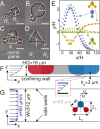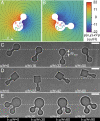Universal motion of mirror-symmetric microparticles in confined Stokes flow
- PMID: 32839312
- PMCID: PMC7486782
- DOI: 10.1073/pnas.2005068117
Universal motion of mirror-symmetric microparticles in confined Stokes flow
Abstract
Comprehensive understanding of particle motion in microfluidic devices is essential to unlock additional technologies for shape-based separation and sorting of microparticles like microplastics, cells, and crystal polymorphs. Such particles interact hydrodynamically with confining surfaces, thus altering their trajectories. These hydrodynamic interactions are shape dependent and can be tuned to guide a particle along a specific path. We produce strongly confined particles with various shapes in a shallow microfluidic channel via stop flow lithography. Regardless of their exact shape, particles with a single mirror plane have identical modes of motion: in-plane rotation and cross-stream translation along a bell-shaped path. Each mode has a characteristic time, determined by particle geometry. Furthermore, each particle trajectory can be scaled by its respective characteristic times onto two master curves. We propose minimalistic relations linking these timescales to particle shape. Together these master curves yield a trajectory universal to particles with a single mirror plane.
Keywords: Hele–Shaw flow; microfluidics; particle-laden flow.
Copyright © 2020 the Author(s). Published by PNAS.
Conflict of interest statement
The authors declare no competing interest.
Figures




Similar articles
-
Hydrodynamically induced helical particle drift due to patterned surfaces.Proc Natl Acad Sci U S A. 2022 Aug 2;119(31):e2202082119. doi: 10.1073/pnas.2202082119. Epub 2022 Jul 28. Proc Natl Acad Sci U S A. 2022. PMID: 35901211 Free PMC article.
-
Calculating the motion of highly confined, arbitrary-shaped particles in Hele-Shaw channels.Microfluid Nanofluidics. 2018;22(8):77. doi: 10.1007/s10404-018-2092-y. Epub 2018 Jul 12. Microfluid Nanofluidics. 2018. PMID: 30881266 Free PMC article.
-
Engineering particle trajectories in microfluidic flows using particle shape.Nat Commun. 2013;4:2666. doi: 10.1038/ncomms3666. Nat Commun. 2013. PMID: 24177694
-
Dielectrophoretic separation of bioparticles in microdevices: a review.Electrophoresis. 2014 Mar;35(5):691-713. doi: 10.1002/elps.201300424. Epub 2014 Feb 4. Electrophoresis. 2014. PMID: 24338825 Review.
-
Flow lithography for structured microparticles: fundamentals, methods and applications.Lab Chip. 2022 Oct 25;22(21):4007-4042. doi: 10.1039/d2lc00421f. Lab Chip. 2022. PMID: 35920614 Review.
Cited by
-
Microfluidic Platform with Serpentine Geometry Providing Chaotic Mixing in Induction Time Experiments.Cryst Growth Des. 2022 Jul 6;22(7):4072-4085. doi: 10.1021/acs.cgd.1c01436. Epub 2022 Jun 9. Cryst Growth Des. 2022. PMID: 35818383 Free PMC article.
-
Low-cost fluorescence microscope with microfluidic device fabrication for optofluidic applications.HardwareX. 2023 Mar 31;14:e00415. doi: 10.1016/j.ohx.2023.e00415. eCollection 2023 Jun. HardwareX. 2023. PMID: 37078005 Free PMC article.
-
Hydrodynamically induced helical particle drift due to patterned surfaces.Proc Natl Acad Sci U S A. 2022 Aug 2;119(31):e2202082119. doi: 10.1073/pnas.2202082119. Epub 2022 Jul 28. Proc Natl Acad Sci U S A. 2022. PMID: 35901211 Free PMC article.
-
Goblet cell interactions reorient bundled mucus strands for efficient airway clearance.PNAS Nexus. 2023 Nov 10;2(11):pgad388. doi: 10.1093/pnasnexus/pgad388. eCollection 2023 Nov. PNAS Nexus. 2023. PMID: 38024407 Free PMC article.
-
Design and Validation of a Droplet-based Microfluidic System To Study Non-Photochemical Laser-Induced Nucleation of Potassium Chloride Solutions.Cryst Growth Des. 2023 Jul 19;23(8):6067-6080. doi: 10.1021/acs.cgd.3c00591. eCollection 2023 Aug 2. Cryst Growth Des. 2023. PMID: 37547880 Free PMC article.
References
-
- Bauer J., et al. , Ritonavir: An extraordinary example of conformational polymorphism. Pharm. Res. 18, 859–866 (2001). - PubMed
-
- Shet A. R., Bates S., Muller F. X., Grant D. J., Polymorphism in piroxicam. Crys. Growth Des. 4, 1091–1098 (2004).
-
- Thompson R., et al. , New directions in plastic debris. Science 310, 1117b (2005). - PubMed
Publication types
LinkOut - more resources
Full Text Sources

